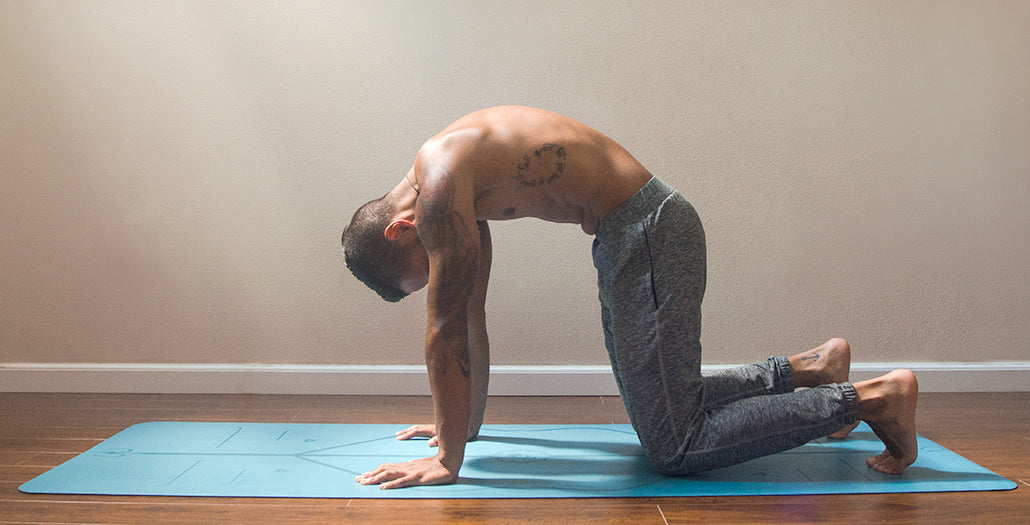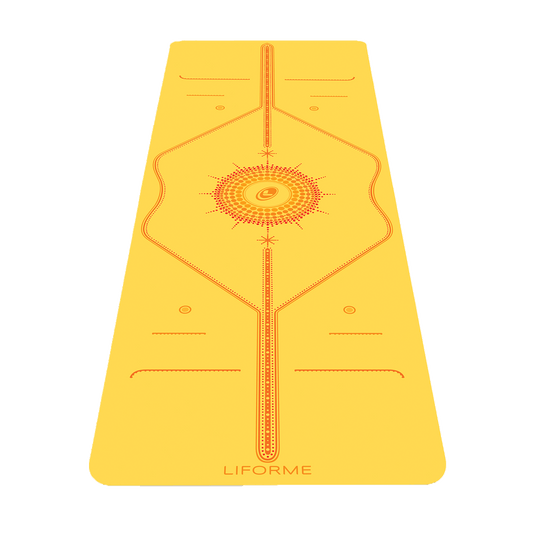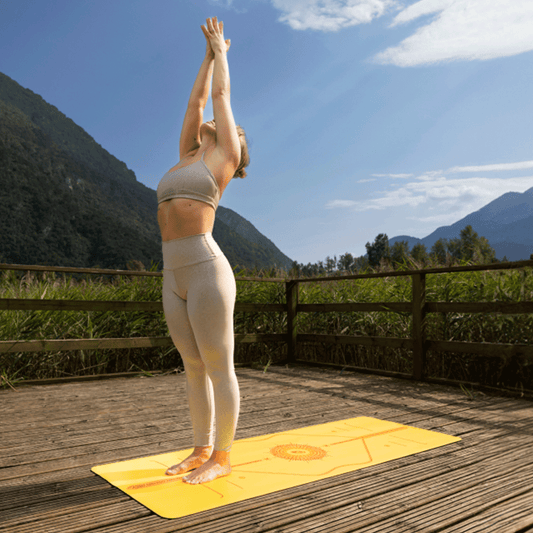Here, we’ll take a pelvis-oriented approach to three types of Cat-Cow movements: Classic hands and knees, a seated chair version, and supine pelvic tilts.
Benefits of Cat-Cow Stretches
Promotes healthy spinal movement
Tones the abdominal muscles
Improves body awareness
Combats the effects of sitting
Classic Cat-Cow
1. Begin on your hands and knees. Make sure that your wrists are directly underneath your shoulders and your knees are directly underneath your hips. Many people tend to place the knees a little too far back. Stacking everything nice and square ensures that you’ll have a solid foundation from which to move. Spread your fingers and press down through your finger pads. Externally rotate your upper arms so that your elbow creases are facing forward. Look at the floor just in front of your hands to keep your neck in a neutral position.
2. When you are all set up, stop and think about how you’re going to move so that you have an intention. Try initiating all movement from the pelvis. It may help to imagine the pelvis as a bowl full of water (you’ll see why in a minute!).

Cow Pose:
3. On an inhalation, tip your pelvis forward so that the (imaginary) water pours out the front of the pelvic bowl.
4. Lift your tail and flare your sit bones.
5. Your abdomen will naturally curve toward the floor, but keep your belly button drawing in toward your spine.
6. Extend your neck so that you’re looking up at the ceiling. Your spine from tail to neck will be in the shape of a U.

Cat Pose:
7. On your next exhalation, scoop your pelvis back under, stopping the (imaginary) water from pouring out.
8. Tuck your tail and round your spine like an angry cat.
9. Continue draw in your belly button.
10. Release your neck and curl your head so that your gaze comes towards your navel. This is a position of flexion for the spine that continues up through the neck.
11. Continue moving slowly back and forth between Cow and Cat on each inhalation and exhalation. Five to ten rounds usually works out the kinks and provides a nice warm-up.
Variations:
Once you get going, it can feel good to take your movements a little further. On your exhales, this might look like drawing your butt back to your heels and rounding your spine into a Child’s Pose with the knees together. On your inhales, try slithering your chest forward close to the mat in a Cobra-like movement. You might also circle or sway the hips. Take this opportunity to move intuitively.
Seated Chair Cat-Cow
Seated Cat-Cow works well in situations where you can’t get down on all fours due to injury, being on an aeroplane, or sitting at your desk at work, for instance. Your pelvis doesn’t have as much freedom of movement when you’re sitting, but you can still get some good lubrication of the spinal column.
Start by placing both feet as flat on the floor as possible. You may need to adjust your chair or take off your shoes to make this work but it’s worth it to create a stable, even seat. If your chair puts you in a position where your hips are below your knees, scoot forward so your knees and hips are as close to level as possible. Place your hands on your knees with your arms straight.
Seated Cow:
1. On an inhalation, tip the pelvis forward and feel that action take your low back into spinal extension (a backbend).
2. As the movement continues up your spine, blossom your chest through your shoulders, allowing your upper arms to roll out a bit.
3. Lift your head to take your gaze gently to the ceiling. No need to throw your head back as that will only crunch up your neck.
Seated Cat:
4. On an exhalation, tuck your tail under, moving the pelvis to a posterior position.
5. Round the spine, letting your shoulders roll forward as your chin drops to your chest.
6. Move through several rounds of the stretch to counteract the effects of staring at a computer monitor for long hours.
Pelvic Tilts
The pelvic tilt is a supine version of a Cat-Cow with an emphasis on (surprise!) the pelvis. The underrated exercise is actually great preparation for yoga asana practice and an awesome way to improve pelvic awareness while strengthening the muscles of the back and abdomen. Pelvic tilts are often prescribed by physical therapists for the prevention of back pain.
1. Lie down on your back with your knees bent toward the ceiling and the soles of your feet flat on the floor. With your pelvis in a neutral position, the natural curve of the lumbar spine should create a small amount of space between the lower spine and the floor.
2. On an inhalation, press your sitting bones (the lower back side of the pelvis) into the mat to arch your lumbar spine away from the floor, emphasising it’s natural curve.
3. On your next exhale, curve your pubis (lower front side of the pelvis) toward your face to flatten your low back to the mat, removing any space between your back and the floor.
That’s all there is to it! It’s a very subtle movement that doesn’t have to be big to be effective. In fact, try to keep your movements small with a concentration on the back and forth of the pelvis. At no point do your hips leave the floor. Doing pelvic tilts also helps give you a better understanding of the movement of the pelvis in Cat-Cow stretches on all-fours and in a seated position.





































